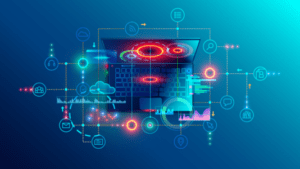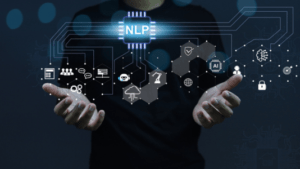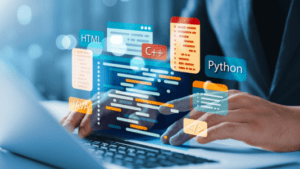Table of contents:
- Background on Artificial Intelligence and Software Development
- Purpose and Scope of the Paper
AI Techniques in Software Requirements Engineering
- Natural Language Processing for Requirements Analysis
- Automated Requirement Elicitation and Prioritization
- AI-Driven Requirement Traceability
AI-Driven Software Design and Architecture
- AI-Assisted Design Pattern Recognition
- Generative Adversarial Networks for Design Exploration
- Automated Architecture Evaluation and Optimization
AI-Enabled Software Coding
- Code Generation and Auto-completion
- AI-Based Code Refactoring
- Debugging and Error Detection with AI
AI in Software Testing and Quality Assurance
- Test Case Generation and Prioritization
- Automated Test Execution and Result Analysis
- AI-Driven Defect Prediction and Quality Assessment
AI for Software Maintenance and Evolution
- Automated Bug Detection and Resolution
- Predictive Maintenance and Anomaly Detection
- AI-Based Software Evolution Analysis
Challenges and Ethical Considerations
- Bias and Fairness in AI-Driven Software Development
- Privacy and Security Concerns
- Impact on Software Development Workforce
Future Directions and Concluding Remarks
- Emerging Trends and Technologies in AI and Software Development
- Potential Opportunities and Risks Ahead
- Summary of the Paper’s Findings
1.1 Background on Artificial Intelligence and Software Development
Artificial Intelligence (AI) refers to the development of computer systems that can perform tasks that typically require human intelligence, such as learning, reasoning, and problem-solving. Software development, on the other hand, involves the process of creating and maintaining software systems. AI has made significant strides in recent years, leading to advancements in various fields. One area where AI has had a profound impact is software development.
1.2 Purpose and Scope of the Paper
The purpose of this paper is to explore the impact of AI on software development and examine how AI-driven techniques and tools have transformed the entire software development lifecycle. It aims to provide an in-depth analysis of the key areas where AI has made significant contributions, discuss the benefits and challenges associated with AI integration in software development, and consider the ethical considerations of leveraging AI in this domain.
AI Techniques in Software Requirements Engineering
2.1 Natural Language Processing for Requirements Analysis
One of the fundamental challenges in software development is gathering and analyzing requirements. AI techniques, such as Natural Language Processing (NLP), have improved the efficiency and accuracy of requirements analysis. NLP algorithms can extract relevant information from textual documents, enabling software engineers to better understand user needs and create precise and unambiguous requirements.
2.2 Automated Requirement Elicitation and Prioritization
AI can automate the process of requirement elicitation by analyzing user feedback, customer reviews, and other data sources. Machine Learning (ML) algorithms can identify patterns and extract valuable insights, helping software developers prioritize requirements based on user preferences and business goals.
2.3 AI-Driven Requirement Traceability
AI techniques, including semantic analysis and knowledge representation, facilitate requirement traceability. By linking requirements to design elements and test cases, AI-powered tools enable developers to track the origin, implementation, and verification of each requirement, ensuring comprehensive coverage and enhancing system reliability.
AI-Driven Software Design and Architecture
3.1 AI-Assisted Design Pattern Recognition
AI algorithms can analyze existing software systems to identify common design patterns and best practices. By leveraging this knowledge, developers can make informed decisions during the design phase, improving the overall quality and maintainability of the software.
3.2 Generative Adversarial Networks for Design Exploration
Generative Adversarial Networks (GANs) have shown promise in generating new design alternatives based on existing examples. GANs can explore the design space and propose novel solutions, enabling developers to consider a broader range of possibilities and optimize software design.
3.3 Automated Architecture Evaluation and Optimization
AI techniques, such as reinforcement learning and genetic algorithms, can automatically evaluate and optimize software architectures. These methods can identify architectural flaws, suggest improvements, and enhance the system’s performance, scalability, and reliability.
AI-Enabled Software Coding
4.1 Code Generation and Auto-completion
AI-based code generation tools, such as deep learning models and transformer networks, can assist developers by automatically generating code snippets for repetitive or boilerplate tasks. Additionally, AI-powered auto-completion features in Integrated Development Environments (IDEs) can suggest relevant code segments, reducing development time and improving coding efficiency.
4.2 AI-Based Code Refactoring
Code refactoring involves improving the structure and design of existing code without changing its functionality. AI techniques can analyze codebases, identify areas for improvement, and propose refactoring options, helping developers enhance code readability, maintainability, and performance.
4.3 Debugging and Error Detection with AI
AI algorithms can aid in debugging and error detection by analyzing code and identifying potential issues. Machine learning models can learn from past debugging experiences and suggest possible fixes, assisting developers in diagnosing and resolving software bugs more efficiently.
AI in Software Testing and Quality Assurance
5.1 Test Case Generation and Prioritization
AI techniques, such as Genetic Algorithms and Reinforcement Learning, can generate diverse and effective test cases, improving test coverage and reducing the reliance on manual test case creation. AI can also prioritize test cases based on code changes, historical defect data, and criticality analysis, ensuring efficient testing.
5.2 Automated Test Execution and Result Analysis
AI can automate the execution and evaluation of test cases by leveraging techniques like Robotic Process Automation (RPA) and ML-based analysis. This enables faster and more accurate detection of defects, reducing the time and effort required for manual testing.
5.3 AI-Driven Defect Prediction and Quality Assessment
Machine learning models can analyze historical defect data, code metrics, and project-specific factors to predict the likelihood of defects in different software components. By proactively identifying high-risk areas, developers can focus their efforts on preventing and mitigating potential issues, leading to higher software quality.
AI for Software Maintenance and Evolution
6.1 Automated Bug Detection and Resolution
AI techniques, such as anomaly detection algorithms and bug prediction models, can identify and prioritize potential software bugs. By continuously monitoring software behavior and user feedback, AI-powered systems can detect anomalies and provide insights to aid in bug resolution, leading to faster bug fixes and improved software stability.
6.2 Predictive Maintenance and Anomaly Detection
AI can facilitate predictive maintenance by analyzing software usage patterns and sensor data to identify potential failures before they occur. This enables proactive maintenance and reduces downtime, ensuring optimal system performance and user satisfaction.
6.3 AI-Based Software Evolution Analysis
AI algorithms can analyze software repositories, version control systems, and bug tracking data to understand how software evolves over time. This analysis can provide insights into development patterns, code hotspots, and the impact of changes, facilitating more informed decision-making during software evolution.
Challenges and Ethical Considerations
7.1 Bias and Fairness in AI-Driven Software Development
AI models and algorithms can inherit biases present in training data, potentially leading to biased software systems. Ensuring fairness and mitigating bias is a critical consideration in AI-driven software development. Developers must be mindful of the potential biases and take appropriate measures to address them.
7.2 Privacy and Security Concerns
The integration of AI into software development raises privacy and security concerns. AI systems often process sensitive user data, and protecting this data from unauthorized access or misuse is of utmost importance. Developers must implement robust security measures and adhere to privacy regulations to maintain user trust.
7.3 Impact on Software Development Workforce
AI’s automation capabilities in software development may lead to concerns about job displacement. While AI can automate repetitive tasks, it also creates new opportunities for software developers to focus on complex problem-solving, innovation, and higher-level tasks. Adapting to the evolving nature of software development and upskilling to leverage AI will be essential for professionals in the field.
Future Directions and Concluding Remarks
8.1 Emerging Trends and Technologies in AI and Software Development
The field of AI is rapidly evolving, with new techniques, algorithms, and tools emerging constantly. Future developments may include advancements in Explainable AI (XAI), AI-powered collaboration and teamwork, and further integration of AI into Agile and DevOps methodologies. Keeping track of these emerging trends will be crucial for staying at the forefront of software development practices.
8.2 Potential Opportunities and Risks Ahead
While AI presents immense opportunities for improving software development, there are also risks to consider. Ethical concerns, data privacy challenges, and the need for ongoing research and development pose potential risks. Striking the right balance between leveraging AI’s capabilities and addressing these risks will shape the future of AI-driven software development.
8.3 Summary of the Paper’s Findings
This paper has explored the significant impact of AI on software development. AI techniques have revolutionized various stages of the software development lifecycle, enhancing requirements engineering, design, coding, testing, maintenance, and evolution processes. The integration of AI has resulted in increased efficiency, accuracy, and productivity while posing challenges related to bias, privacy, and workforce implications.
Conclusion
Recap of Key Points
This paper has highlighted the transformative impact of AI on software development. AI-driven techniques and tools have improved requirements engineering, design, coding, testing, maintenance, and evolution processes, leading to enhanced software quality and productivity.
Final Thoughts on the Impact of AI on Software Development
AI’s impact on software development is undeniable, and its continued advancements hold great promise for the future. As AI becomes more sophisticated and widespread, it will be crucial for developers to leverage its capabilities while ensuring ethical and responsible practices to address challenges and maximize the benefits of AI in software development.



